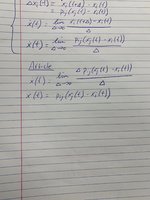Hi folks,
I have a bit of a hard time finding the right math theory behind the following transformation of the difference equation into a differential one ('delta' means the difference):
Difference equation: 'delta'xi(k) = pij(xj(k)-xi(k))
Differential equation according the scientific article: xi'(t) = pij(xj(t)-xi(t)) -- they say they assume infinitesimal changes and use taylor expansion to derive this
For the record, xi and xj mean the strategy of player i and j, respectively. pij is a transition probability.
Does someone have an idea?
I have a bit of a hard time finding the right math theory behind the following transformation of the difference equation into a differential one ('delta' means the difference):
Difference equation: 'delta'xi(k) = pij(xj(k)-xi(k))
Differential equation according the scientific article: xi'(t) = pij(xj(t)-xi(t)) -- they say they assume infinitesimal changes and use taylor expansion to derive this
For the record, xi and xj mean the strategy of player i and j, respectively. pij is a transition probability.
Does someone have an idea?

